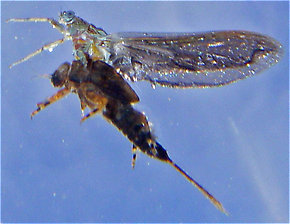Blog & Latest Updates
Fly Fishing Articles
Insects by Common Name


Caddisfly Species Brachycentrus appalachia (Apple Caddis)
Taxonomic Navigation -?-
Kingdom
Animalia (Animals)
» Phylum
Arthropoda (Arthropods)
» Class
Insecta (Insects)
» Order
Trichoptera (Caddisflies)
» Genus
Brachycentrus (Grannoms)
» Species appalachia (Apple Caddis)
Common Names
| Match | Common Name |
| Apple Caddis | |
| Light Grannom | |
| Light Shadfly | |
| Grannom | |
| Shad Fly |
The common name comes from the bright apple-green color of its abdomen.
Where & When
This species produces intense, reliable hatches in the Catskills sometime in between the peaks of Ephemerella subvaria (Hendricksons) and Ephemerella invaria (Sulphurs).
Special thanks to Lloyd Gonzales, author of the excellent new book Fly-Fishing Pressured Water, for helping to sort out the Brachycentrus species and common names.
Pictures of 3 Caddisfly Specimens in the Species Brachycentrus appalachia:
Brachycentrus appalachia (Apple Caddis) Caddisfly Adult View 13 PicturesI captured this specimen in the same color as this photograph, during its egg-laying flight. The emergers are much lighter.
View 13 PicturesI captured this specimen in the same color as this photograph, during its egg-laying flight. The emergers are much lighter.
 View 13 PicturesI captured this specimen in the same color as this photograph, during its egg-laying flight. The emergers are much lighter.
View 13 PicturesI captured this specimen in the same color as this photograph, during its egg-laying flight. The emergers are much lighter.Collected May 13, 2007 from the West Branch of the Delaware River in New York
Added to Troutnut.com by Troutnut on May 18, 2007
Added to Troutnut.com by Troutnut on May 18, 2007
Brachycentrus appalachia (Apple Caddis) Caddisfly Adult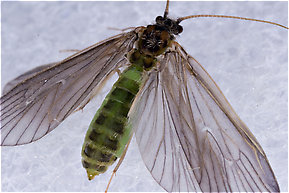 View 9 PicturesThe wings of this specimen were pale tan, almost white, when I collected it, and the body was of the lighter "apple green" from which this species gets its common name. Everything turned much darker by the time I got it home and under the camera.
View 9 PicturesThe wings of this specimen were pale tan, almost white, when I collected it, and the body was of the lighter "apple green" from which this species gets its common name. Everything turned much darker by the time I got it home and under the camera.
The wings look even darker in some of these pictures because the background is black and the wings are unusually translucent. You can see that in one of the pictures where the body easily through the wings. They're really a light, translucent gray, which is still far from the pale tan of the same fly when it was freshly emerged.
 View 9 PicturesThe wings of this specimen were pale tan, almost white, when I collected it, and the body was of the lighter "apple green" from which this species gets its common name. Everything turned much darker by the time I got it home and under the camera.
View 9 PicturesThe wings of this specimen were pale tan, almost white, when I collected it, and the body was of the lighter "apple green" from which this species gets its common name. Everything turned much darker by the time I got it home and under the camera.The wings look even darker in some of these pictures because the background is black and the wings are unusually translucent. You can see that in one of the pictures where the body easily through the wings. They're really a light, translucent gray, which is still far from the pale tan of the same fly when it was freshly emerged.
Collected May 15, 2007 from the West Branch of the Delaware River in New York
Added to Troutnut.com by Troutnut on May 18, 2007
Added to Troutnut.com by Troutnut on May 18, 2007
Brachycentrus appalachia (Apple Caddis) Caddisfly Adult View 5 Pictures
View 5 Pictures
 View 5 Pictures
View 5 PicturesCollected May 7, 2005 from the Beaverkill River in New York
Added to Troutnut.com by Troutnut on May 16, 2006
Added to Troutnut.com by Troutnut on May 16, 2006
3 Underwater Pictures of Brachycentrus appalachia Caddisflies:
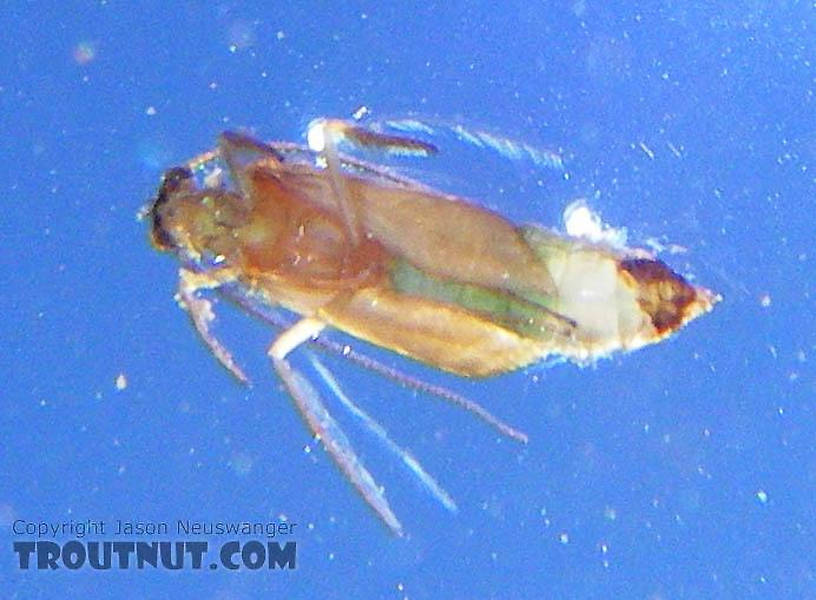
A Brachycentrus "Apple Caddis" pupa scoots around in the surface film. Apparently it had some difficulty emerging, so I was able to slip my camera underneath it and take a picture from below.
In this picture: Caddisfly Species Brachycentrus appalachia (Apple Caddis).
In this picture: Caddisfly Species Brachycentrus appalachia (Apple Caddis).
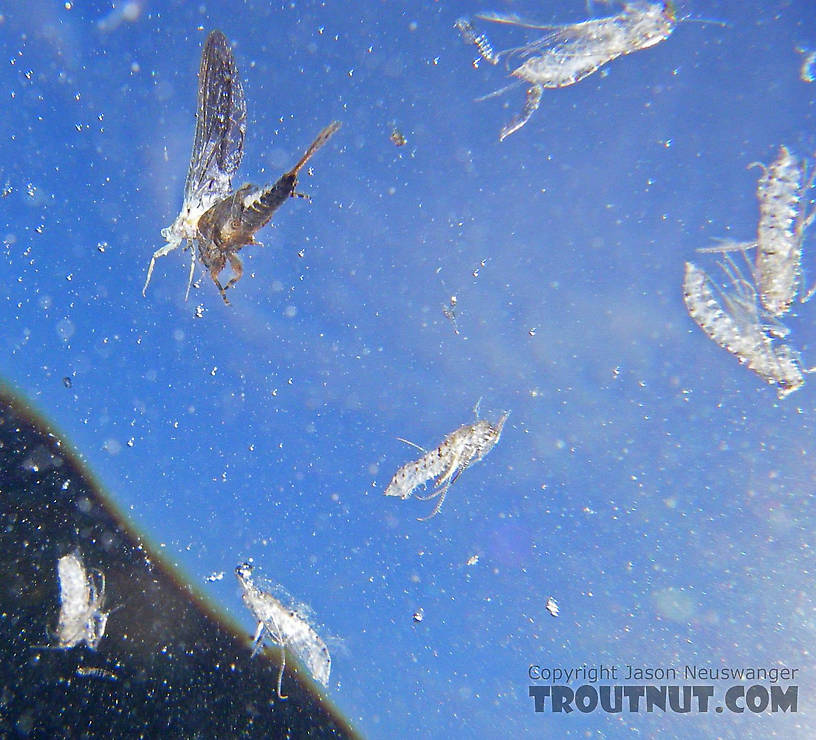
This picture from below shows a stillborn (Stillborn: In fly fishing, a stillborn insect is one which got stuck in its nymphal or pupal shuck during emergence and floats helplessly on the surface instead of flying away. It is a specific class of cripple, although it is sometimes used interchangeably with that term.) Ephemerella subvaria (Hendrickson) dun drifting on the surface amidst a number of shed pupal skins from Brachycentrus caddisflies which were heavily hatching that day.
In this picture: Caddisfly Species Brachycentrus appalachia (Apple Caddis) and Mayfly Species Ephemerella subvaria (Hendrickson).
In this picture: Caddisfly Species Brachycentrus appalachia (Apple Caddis) and Mayfly Species Ephemerella subvaria (Hendrickson).
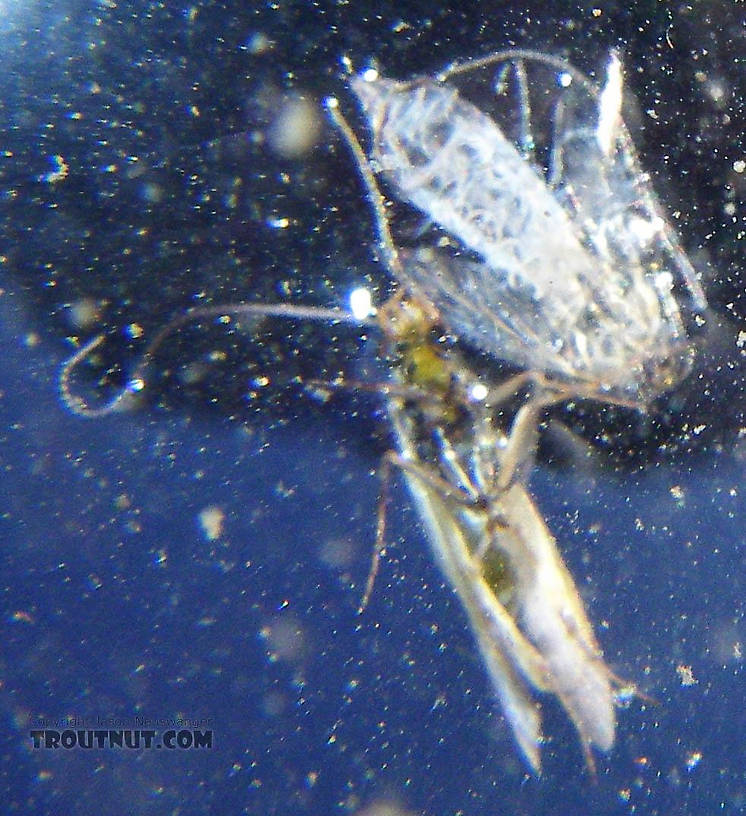
This Brachycentrus "Apple Caddis" struggled more than its kin in escaping its pupal skin, enabling me to take an underwater picture of it from directly below. This is sort of a trout's eye view, but I used the flash for the picture so the transparent shuck (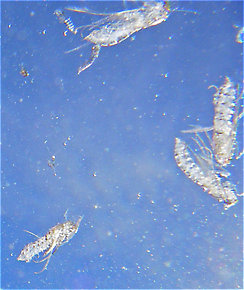 Shuck: The shed exoskeleton left over when an insect molts into its next stage or instar. Most often it describes the last nymphal or pupal skin exited during emergence into a winged adult.) appears far brighter than it really is.
Shuck: The shed exoskeleton left over when an insect molts into its next stage or instar. Most often it describes the last nymphal or pupal skin exited during emergence into a winged adult.) appears far brighter than it really is.
In this picture: Caddisfly Species Brachycentrus appalachia (Apple Caddis).

Here's an underwater view of the pupal shucks of several already-emerged Brachycentrus numerosus caddisflies.
In this picture: Caddisfly Species Brachycentrus appalachia (Apple Caddis).
Your Thoughts On Brachycentrus appalachia:
Top 10 Fly Hatches
Top Gift Shop Designs
Eat mayflies.
Top Insect Specimens
Miscellaneous Sites
Troutnut.com is copyright © 2004-2024 Jason
Neuswanger (email Jason). See my FAQ for information about use of my images.
 privacy policy
privacy policy

